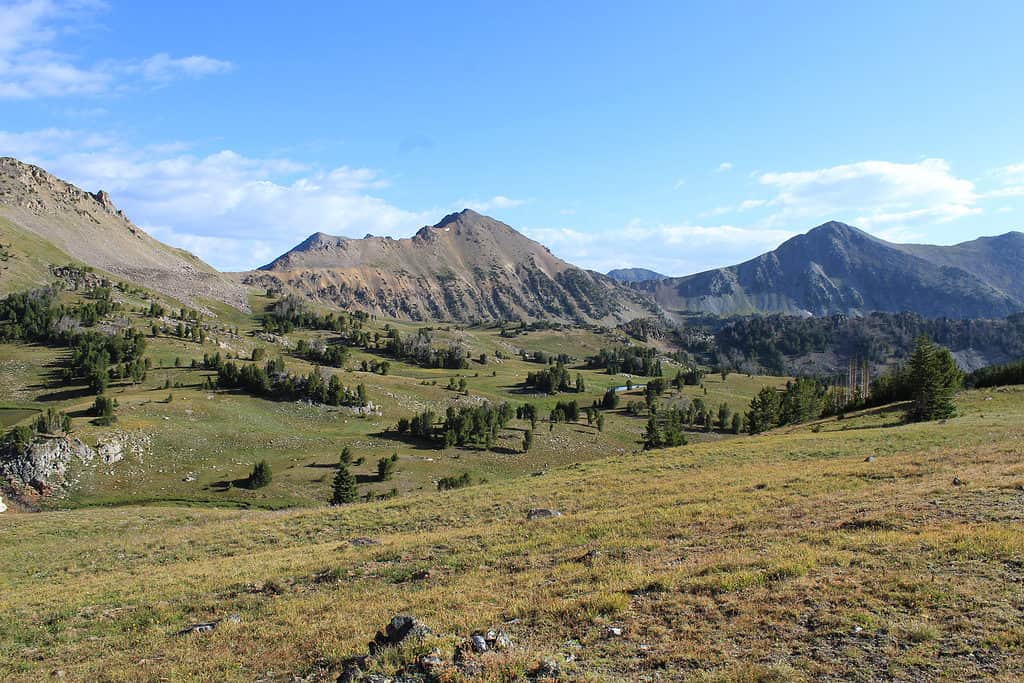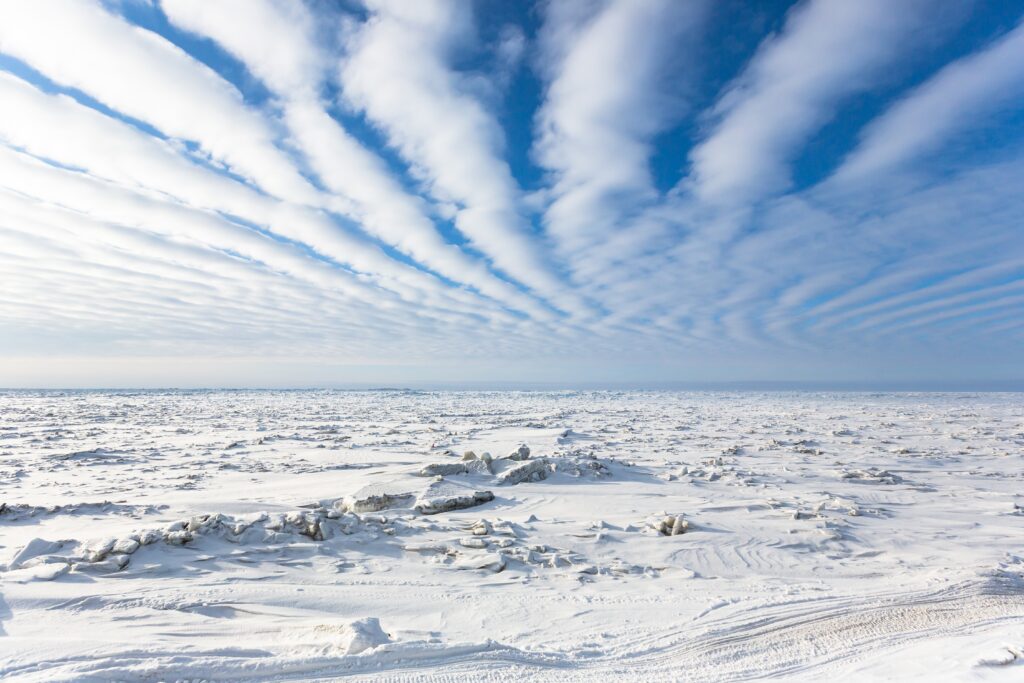Every million years, giant rocks from outer space – mainly asteroids and meteors – smash into the Earth’s surface and form impact craters. Some of these visitors to our planet are tricky to trace because of erosion and weathering. But thankfully, the Earth Impact Database (EID) keeps track of circular depressions and has so far confirmed the U.S. is home to at least 28 of them. Their diameters range from 0.1 to 90 kilometers.
This article discusses the 10 largest and most consequential impact craters in the U.S. We detail when and where they occurred, their sizes, and how they transformed our world. Let’s begin!
1. Chesapeake Bay Crater

Previous to Poag’s discovery, the crater remained hidden beneath Chesapeake Bay’s floor.
©Jon Bilous/Shutterstock.com
C. Wylie Poag discovered the Chesapeake Bay Crater in the early 1990s. It is the most significant impact crater in the U.S., with a diameter of 85 km (53 miles). Previous to Poag’s discovery, it remained hidden beneath Chesapeake Bay’s floor. In fact, his team found it by a fluke—Poag was only in the vicinity for an offshore drilling project.
This crater’s existence was caused by a unique geological event around 35 million years ago near Virginia’s present-day Hampton Beach. A bolide estimated to have been about three km long traveled at 144,000 mph, hitting the coastal region and excavating a 1.3 km-deep depression. The violent impact triggered the following:
Disrupted Ground-Water Aquifers
The crater impact truncated and excavated coastal aquifers within the region. Today, a large reservoir occupies the space. This reservoir has pore spaces with saline water up to 1.5 times saltier than typical seawater, preventing it from being used for drinking or industrial purposes.
River Diversion
The bolide impact also affected the flow of rivers. While most rivers, such as the Rappahannock, now flow southeast to the Atlantic, the York, and James Rivers head northeastward at the crater’s outer rim.
Other effects of the Chesapeake Bay Crater were a giant tsunami, ground instability, molten debris, and land subsidence.
2. Beaverhead Crater

Many events have disrupted the crater over time, so you might not find any remnants, save for a few shatter cones in the Beaverhead Mountains.
©Emily Kerns/Shutterstock.com
With a diameter of 60 km (37 miles), Beaverhead is second on our list of the biggest U.S. impact craters. Nestled between Idaho and Montana, this 600-million-year-old crater is rather weathered and exposed. In addition, many displacement and regional events have also disrupted it over time, so you might not find any remnants, save for a few shatter cones in the Beaverhead Mountains.
Although nothing much remains of the Beaverhead Crater, scientists believe it’s still unique and vital to geologists. This is because it preserves pseudotachylite (fine-grained dark, glassy cohesive rocks), suggesting they were exhumed shortly after they formed. In addition, it has brought scientists and geophysicists from different parts of the country together.
3. Manson Crater
Situated near Manson, Iowa, the Manson Crater was once believed to be the biggest impact event in the United States. However, it’s already been dethroned since its diameter is 35 km (22 miles), 50 km smaller than that of the nation’s largest crater at Chesapeake Bay.
The Manson Crater was created during the Late Cretaceous period (145-66 million years ago) when a comet or asteroid nucleus hit the Earth. Some scientists theorized it may have caused the dinosaurs to die out, but isotopic dating confirmed it’s too old to have played a part in the animals’ extinction.
4. Ames Crater
A meteor traveling at roughly 70,000 mph (110,000 km/h) hit Oklahoma’s Major County in the Middle Ordovician era to form Ames Crater, with a diameter of 16 km (10 miles). It hid under a thick layer of around 9,000 feet of residue for centuries until it was unearthed in 1991.
Excited, geologists drilled within the depression to find substantial amounts of oil and gas, putting it on the list of oil-producing craters in the U.S. More than 60 wells are on site today, and about half are known petroleum sources.
5. Sierra Madera Crater
Like Arizona’s Barringer, the Sierra Madera Crater in Pecos County, Texas, is easy to locate because it’s visible from various points, including U.S. Route 385. It measures 13 km, or 8 miles, in diameter and is estimated to be up to 100 million years old.
In addition, Sierra Madera sits on the now-closed private property of La Escalera Ranch. This area is known as the training location for accomplished geologists and aviators, including Jack Schmitt and Gene Cernan.
6. Marquez Crater
You’ll find Marquez Crater in Leon County, about 230.3 km (143.1 miles) from Austin, Texas. Scientists believe the natural formation is 56-60 million years old. Although its diameter is 12.7 km (8 mi), a large chunk of it is unexposed, save for the Marquez Dome, which comprises impacted rocks and shatter cones. Additionally, shallow sediments surround this complex impact crater.
7. Avak Crater

After examining its ejecta, scientists concluded this crater in Utqiagvik, Alaska was formed about 90 million years ago.
©iStock.com/Wirestock
Nestled southeast of Utqiagvik, Alaska, Avak is a subcircular impact crater with a diameter of 12 km (7.5 mi). Its estimated depth is 1 km (0.62 mi), and inside, there are metamorphic basement rocks and uplifted and massively deformed sedimentary material. Moreover, a distinct thin covering of permanently frozen Pleistocene and Pliocene surrounds the structure. After examining its ejecta, scientists concluded this crater was formed about 90 million years ago.
8. Wells Creek Crater
Wells Creek is an exposed impact crater near Tennessee’s Cumberland City. Its center harbors incredibly fine shatter cones, which has made it of interest to many, including geologists and nature lovers. While some want to study the rare cone or fan-shaped features, others hope to add them to their collections and display them in shows. This structure’s diameter is 12 kilometers (7.5 mi); scientists say it’s more than 100-300 million years old.
9. Red Wing Crater
Found in McKenzie County, the Red Wing Creek structure is among North Dakota’s top natural lures. Although it’s unexposed and buried beneath roughly 1.24 miles of sedimentary rock, it still fascinates crater enthusiasts, mainly because it has been a source of oil since 1972.
Red Wing’s estimated diameter is 9 km (5.6 miles); scientists revealed it’s over 200 million years. Since oil was discovered around the crater, it’s now a favored destination for geologists and geophysicists. Some experts have made important discoveries to help the world understand more about the event. For instance, Christian Koeberl and his team stumbled upon planar deformation features that confirmed the crater’s impact origin.
10. Calvin Crater
Randall Milstein discovered Calvin in 1987 in Southwest Michigan. Unexposed and situated about 100-400 feet below the ground, the crater has a dimensional diameter of 8.5 km (5 miles). In addition, it features an encircling anticlinal rim, an annular depression, and a central dome. Since it was well hidden, Milstein only found it because he was examining data from gas and oil test wells drilled in Calvin Township. Scientists approximate the Calvin Crater is 440-460 million years old.
What to Know about Impact Craters

A crater’s round shape is caused by material (ejecta) flying out in all directions due to the massive explosion caused by impact.
©Virrage Images/Shutterstock.com
According to scientists, impact events occur after millions of years. As you already know, they cause circular holes on the Earth’s surface. But contrary to popular belief, a crater’s round shape doesn’t mean the debris from outer space was circular. Instead, it’s caused by material (ejecta) flying out in all directions due to the massive explosion caused by impact.
Impact Craters Vary in Shape and Size
Craters in the U.S. and other parts of the world don’t boast the same size and shape. Typically, their features are determined by the impacting object’s velocity, mass, and density, along with the type of surface the object hits.
Usually, the faster the impactor’s speed, the larger the size of the depression caused. Most asteroids and meteorites hit Earth at roughly 20 km/s, creating a hole up to 20 times larger in diameter than the rocks measure. Again, if the objects slam into planets with minimal gravitational pull, they travel at lower speeds, translating into smaller impact craters.
More often than not, craters are circular. But in some rare instances, the impacting object hits the surface at an angle of fewer than 20 degrees, leading to elongated depressions.
Different Types of Impact Craters
Today, you’ll likely find the following types of impact craters on our planet:
- Simple craters are small with a distinct bowl shape and smooth walls.
- Complex craters are large, with a plethora of features, including central peaks, multiple rings, and terraces.
- Impact basins are larger than complex craters and boast diameters wider than 300 kilometers.
- Irregular craters have irregular shapes and may have been formed by many impact craters formed at the same time.
- Multi-ring basins are giant impact craters surrounded by up to six circular rings of mountain chains and a primary rim.
- Degraded craters have eroded over time because of lava flows.
Impact Craters Have Different Parts
Every impact crater – large or small – has these main parts:
Floor
The floor is an impact crater’s dark, flat, or bowl-shaped bottom. It usually comprises the remnants of the impact melt gathered at the hole’s base after the life-altering event. As a rule, the sizes and conditions of the depressions affect the shape of their floors. For instance, complex, simple, and highly degraded impact craters boast flat-floored bottoms.
If an impact crater is large (with several tens of kilometres in diameter), it has central peaks at the floor’s middle area. This usually happens because the depression’s massive size forces it to collapse on itself, increasing the mound at the center and adding to the peak as the rock under the hole bounces back.
Walls
These are the interior, primarily steep, sides of an impact crater. Their features vary from one depression to another, depending on their sizes. For example, simple craters’ walls are smooth, with one slope segment running from the floor to the rim or edge. Sometimes, these small circular holes have two-tier profiles with shallower bits created after debris collects at the main wall slope’s foot.
Unlike simple craters, complex craters have large stair-like terraces moving down into the depression as their walls collapse due to gravity.
Ejecta
These are rock materials forced out of the crater area following an impact event. You’ll likely find them near the edge of the source crater, mostly at distances of up to 5 crater radii or more. Sometimes, you might locate a blanket of debris instead of loose particles.
Typically, ejecta material or blankets have different morphology, depending on the geological features involved in the cratering process, such as kinetic energy. Their variations also let us in on the planetary environment related to the event, including gravity and atmosphere.
The size of an ejecta blanket is based on the size and mass of the impacting object, along with its atmospheric pressure, gravity, temperature, and physical characteristics.
Impact Craters Can Help Determine a Planet’s Age

So far, 9,137 lunar craters have been recognized.
©NASA (image by Lunar Reconnaissance Orbiter) / public domain – License
One of the main reasons scientists value craters as they enable them to estimate the ages of different planetary surfaces. Usually, they count the number of depressions and record their sizes to do that. Older surfaces have been exposed to more impacting objects than newer ones. Therefore, the Moon and Mercury are ancient because they’re chock-full of impact craters. On the other hand, Venus and Earth don’t have many, meaning they’ve been around for fewer years.
Notably, some of Earth’s impact craters are yet to be discovered because of weathering and erosion. But it’s quite the reverse on the Moon since its surface has been unaltered for billions of years, making its depressions more visible. So far, 9,137 lunar craters have been recognized.
Scientists Test Impact Craters Before Confirmation
Some people assume only meteorites and asteroids create craters. But they are also formed after massive explosions and volcanic activities. Because these depressions have similar features, scientists must test craters to verify they result from enormous space rocks crashing into our planet. The procedure entails visiting the crater site to collect rock samples and searching for any shock diagnostics within the area, including multiple planar deformations in shatter cones and minerals.
Unfortunately, testing impact craters on other planets are tricky because scientists lack the ability to collect rock samples. Therefore, most of them count on the images of the circular depressions to estimate aspects such as size. In addition, they research the location to know if it is volcanically active.
Largest Impact Craters in the US
These are the 10 biggest impact craters scattered across the U.S. However, incredibly small ones about the size of molehills also exist. No matter the size of the characteristically circular holes and their locations, they have significant effects that linger for centuries.
Take, for instance, the Chicxulub Crater that formed on Mexico’s Yucatán Peninsula about 66 million years ago. Scientists maintain that it sparked the extinction of the dinosaurs after they roamed the Earth for roughly 17 million decades.
Interestingly, impact craters have their perks, too. For example, these difficult-to-erase cosmic guests are a boon for scientists hoping to study and understand our planet’s geological history.
Additionally, organizations like NASA use them to identify the parts of the lunar surface endowed with potential various resources, such as water. And if you’re a curious outdoor lover, discovering an impact crater is among the most exciting things you can do any day!
Where is Chesapeake Bay Crater Located on a Map?
Situated beneath the estuary of Chesapeake Bay in the United States, the Chesapeake Bay impact crater is an ancient concealed crater resulting from the impact of a large celestial object approximately 35.5 ± 0.3 million years ago during the late Eocene era.
Here is Chesapeake Bay Crater on a map:
The photo featured at the top of this post is © iStock.com/Sebastian Ohlig
Thank you for reading! Have some feedback for us? Contact the AZ Animals editorial team.







